 Humans
Humans  Humans
Humans  Animals
Animals 10 Species That Refused to Go Extinct
 Weird Stuff
Weird Stuff 10 Weird Things People Used to Do at New Year’s
 Our World
Our World 10 Archaeological Discoveries of 2025 That Refined History
 Weird Stuff
Weird Stuff 10 Fascinating Facts You Might Not Know About Snow
 Miscellaneous
Miscellaneous Top 10 Things Crypto Was Supposed to Change & What Actually Did
 History
History 10 Huge Historical Events That Happened on Christmas Eve
 Music
Music 10 Surprising Origin Stories of Your Favorite Holiday Songs
 History
History 10 Less Than Jolly Events That Occurred on December 25
 Weird Stuff
Weird Stuff 10 Funny Ways That Researchers Overthink Christmas
 Humans
Humans 10 Unsung Figures Behind Some of History’s Most Famous Journeys
 Animals
Animals 10 Species That Refused to Go Extinct
 Weird Stuff
Weird Stuff 10 Weird Things People Used to Do at New Year’s
Who's Behind Listverse?

Jamie Frater
Head Editor
Jamie founded Listverse due to an insatiable desire to share fascinating, obscure, and bizarre facts. He has been a guest speaker on numerous national radio and television stations and is a five time published author.
More About Us Our World
Our World 10 Archaeological Discoveries of 2025 That Refined History
 Weird Stuff
Weird Stuff 10 Fascinating Facts You Might Not Know About Snow
 Miscellaneous
Miscellaneous Top 10 Things Crypto Was Supposed to Change & What Actually Did
 History
History 10 Huge Historical Events That Happened on Christmas Eve
 Music
Music 10 Surprising Origin Stories of Your Favorite Holiday Songs
 History
History 10 Less Than Jolly Events That Occurred on December 25
 Weird Stuff
Weird Stuff 10 Funny Ways That Researchers Overthink Christmas
Top 10 Sparkling Legends About Gemstones
Humans love shiny rocks. This magpie tendency to collect pretty stones is found in most cultures and throughout history. For the shiniest and rarest rocks people will spend fortunes. The Pink Star diamond sold for $71 million in 2017. But the value of gems is not just in their monetary worth – many people have given them legendary powers.
Here are ten tales of gemstones and the myths around them.
10 Emeralds
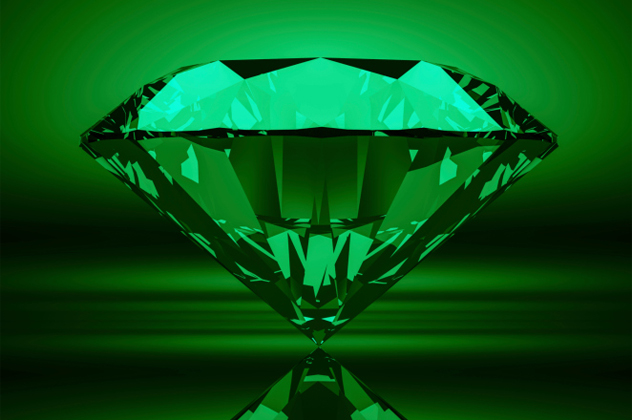
Emeralds have long been sought after by humans. Pliny the Elder tells a story that shows the complex psychology of gemstones. Ismenias the flute-player was overly fond of glittering gems and send away for an emerald ring – but the ring-maker returned some of the gold he paid for it. The flute-player was displeased. “By Hercules! he has done me but a bad turn in this, for the merit of the stone has been greatly impaired by this reduction in price.”
Even emperors could fall under the sway of emeralds however. Nero is said to have used an emerald as a lens through which he viewed gladiators battling to the death. It may be that Nero was short-sighted and emerald was carved to work like a monocle. It may be however that his eyes were simply tired as the Romans believed that emeralds had the power to soothe the eyes.
The Inca are said to have worshipped a large emerald as part of their faith in the goddess Umina. The emerald was supposed to have been Umina’s heart and sick people who touched it were immediately healed. Smaller emeralds were offered to her at the shrine. When the Spanish arrived many of the emeralds were smashed because the invaders thought real emeralds would withstand being hit with a hammer.
9 Rubies
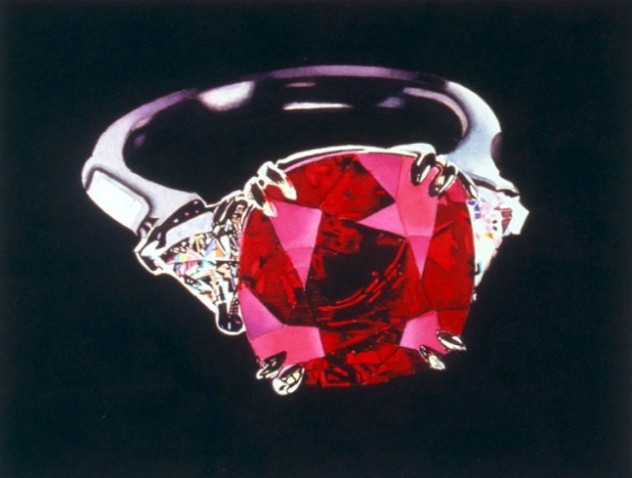
Rubies have always fascinated people because of their rich, blood red colour. There is not just a symbolic link between the colour of these gems and blood – some cultures thought of them literally as blood. The ancient Rigveda of India describes how a horrible demon called Vala took the throne.
Vala was tricked into taking part in a mock sacrifice by the demigods. When he was in place the demigods really did chop up his body and scatter the pieces across the world. Where his blood settled rubies began to spring up. Another Hindu text says that rubies are a fitting offering to the gods. “He who worships Krishna with rubies will be reborn as a powerful emperor. If with a small ruby, he will be born a king.”
Oddly the Ancient Greeks and Romans thought of rubies as gendered. “In each variety of Ruby there are so called “male” and “female” stones, of which the former are the more brilliant, while the latter have a weaker lustre”.
8 Amethyst
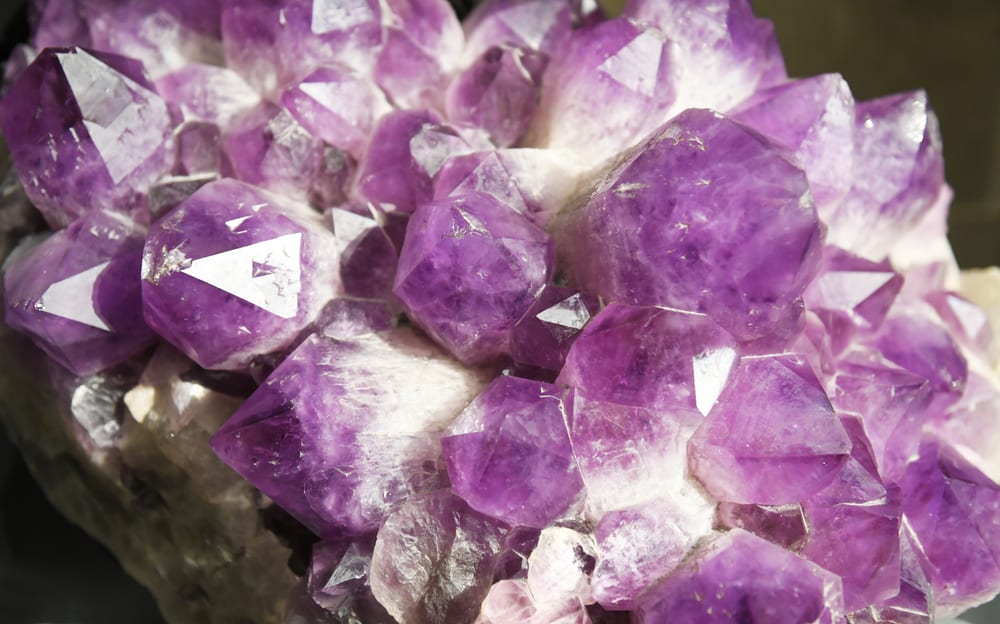
Amethyst is today only a semiprecious stone but in history it was considered one of the most valuable because of its intense purple colour and rarity in Europe. Purple was the colour of Emperors and so it had an aristocratic appeal. It was also said to be magically powerful. Pliny the Elder says that certain dubious sorcerers “tell us also, that if we inscribe the names of the sun and moon upon this stone, and then wear it suspended from the neck, with some hair of the cynocephalus and feathers of the swallow, it will act as a preservative against all noxious spells. It is said too, that worn in any manner, this stone will ensure access to the presence of kings; and that it will avert hail and the attacks of locusts.”
The most common tale told of amethyst is that wearing it can prevent drunkenness. Bishops in the Anglican church are said to wear amethyst rings in commemoration of an event in Acts where St Peter tells a crowd that “These people [the apostles] are not drunk, as you suppose. It’s only nine in the morning!”
The word Amethyst derives from the Greek “amethustos” — “not intoxicated.” Therefore it is perhaps appropriate that the god of wine Dionysus was presented with an amethyst to help preserve his sanity.
7 Pearls
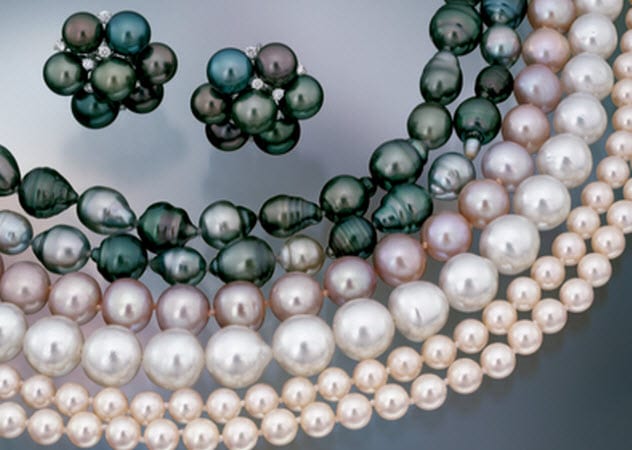
Pearls are used as gemstones but are not actually stones themselves. Several species of molluscs produce pearls – often as a way to trap and protect themselves from parasites. For their beautiful lustre they have always been prized. The Roman historian Suetonius tells us that one of the reasons Julius Caesar invaded Britain was to get access to the pearls in its rivers. Most pearls at the time were sourced from far away in the Indian ocean. Their distant origins allowed many myths to spring up around their origin.
One of the most common beliefs was that pearls were the tears of a god or goddess. For the Greeks they were produced when Aphrodite shed tears of joy. In Japanese mythology it was mermaids that produced them by crying.
Another Japanese myth has pearls being used to defeat a Korean navy. The Empress Jingo of Japan is said to have prayed with sea water in her hands and been provided with the ‘tide jewels’ from the dragon palace at the bottom of the ocean. One was the “pearl of ebb” and another was the “pearl of flood.” When the pearl of ebb was thrown back into the sea the ocean dried up. With the Korean and Japanese navies on the ocean floor the Koreans left their ships to attack the Japanese. It was then that the pearl of flood was thrown down and the waters rushed back in – drowning all the Korean warriors.
6 Amber
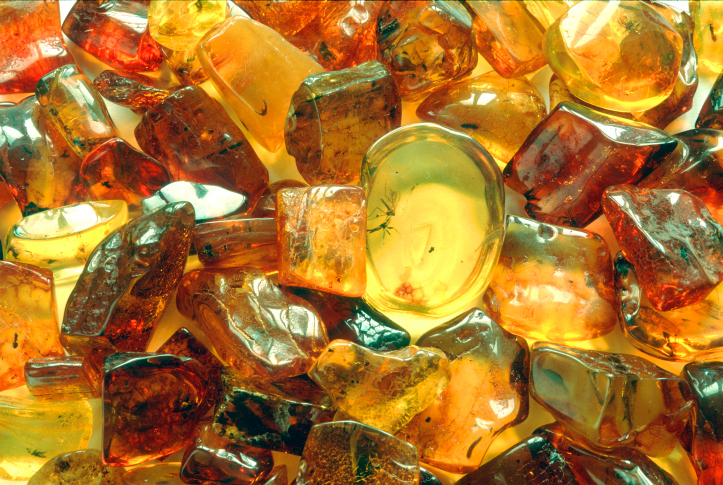
Amber is the fossilised remains of tree resin. It is mostly found with a golden yellow colour but can appear black, green, red, or white. In the ancient world it was mostly found washed up on the shores of the Baltic Sea but was widely traded across Europe and beyond.
To the Greeks and Romans amber was another gem that originated in tears. When Phaeton accidentally drove the chariot of the sun too close to the Earth he risked burning all of humanity and so was cast down to his death in the Eridanus river. When his sisters found his body they wept so fiercely they wasted away and turned to trees on the spot. Their tears kept falling even as trees and turned to amber. This suggests that the ancients were well aware of the connection between tree resin and amber.
According to Lithuanian legend the goddess Jurate lived in an amber palace under the sea. She fell in love with a sailor and the two lived together happily for many years. But when the thunder god found out about their relationship and sent a storm. The palace exploded into millions of pieces. This is why fragments of amber are still washed ashore after a storm.
5 Garnet

Garnets were hugely popular in the Middle Ages. In Britain the Anglo-Saxons used intricately cut garnets housed in gold to decorate their jewellery, armour, and weapons. Legends about garnet go back much further however. Some said that Noah, when out on the ocean in his ark, used a lamp made from garnet to light his way.
The name garnet comes from the Latin “granatus” meaning “seed.” This is probably because garnets are usually found as small nuggets of crystal. When they are deep red in colour they look almost exactly like pomegranate seeds. Because the goddess Persephone was trapped in Hades after consuming pomegranate seeds the gift of garnets was once considered a sure way to make a loved one return to you.
It is said that if you do a good deed while wearing garnets then you will receive good in return. But if you do something evil while wearing one then you will have the evil rebound back on you.
4 Sapphire

Deep blue sapphires are one of the most beautiful of all gems and have fascinated people for millennia. According to some accounts the Ten Commandments that were received by Moses were presented to him carved into two blocks of sapphire. Some saw sapphires as the reason the sky is blue. Ancient Persians thought the dome of heaven rested on sapphire and reflect the colour back down to us.
Sapphires were supposed to have many magical properties. Some said that sapphires could heal by wearing them while others thought they had to be consumed. Powdered sapphire eaten with milk would cure sores. Placing a sapphire on the forehead was thought to stop nosebleeds.
Because of the structure of sapphire crystals they sometimes show a radiant star when polished. These star sapphires were once thought to be particularly mystical. The gems could ward off the ‘evil eye’ and stop people harming you through jealousy.
3 Lapis Lazuli
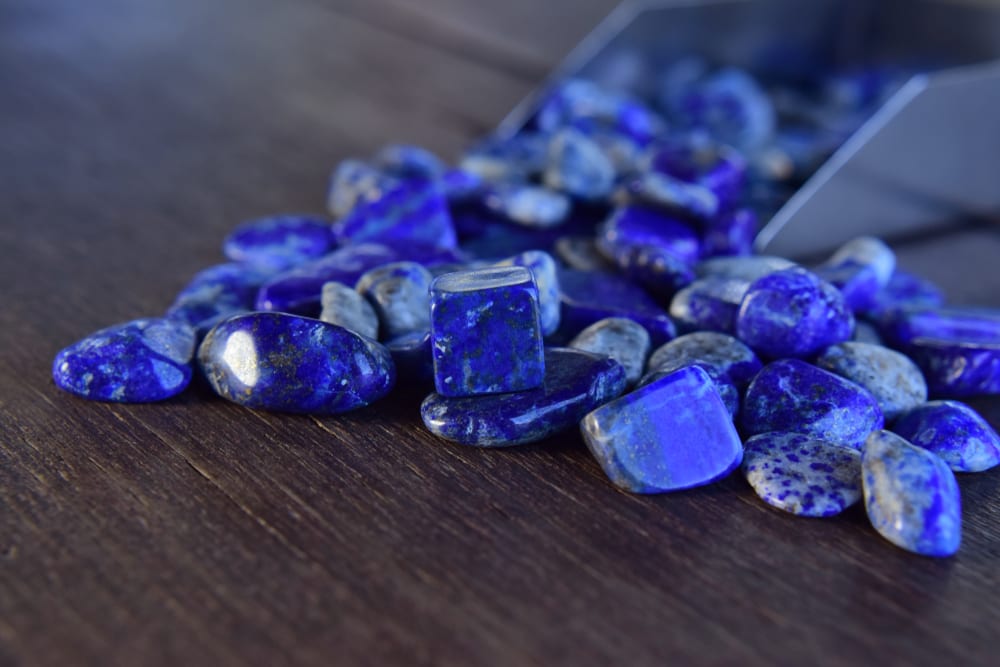
Many ancient accounts of sapphire might actually be a misidentification of another lovely blue stone – lapis lazuli. Once mined only in the high mountains of Afghanistan lapis lazuli was one of the most sought after stones throughout Mesopotamia and Egypt. Evidence of its mining can be found from the 7th millennium BC.
The ancient Sumerians treasured lapis lazuli and thought it was a material worthy of the gods. The goddess Innana is described in ancient texts as wearing jewellery of lapis and carrying a lapis rod. When she went around the underworld she would use her rod to measure out the length of a person’s life. The Babylonians also spoke of a tree that sprouted with lapis lazuli. The Epic of Gilgamesh is thoroughly adorned with lapis lazuli. The terrible Bull of Heaven had horns covered with it and Innana tried to tempt Gilgamesh with a gold and lapis chariot.
The Egyptians used lapis lazuli heavily in their religious practices. The funerary mask of Tutankhamun is covered in lapis. In the Egyptian Book of the Dead we find that the dead body is turned to lapis. “Lord your upper part is lapis lazuli. Your hair is bestrewn with lapis lazuli. Your visage is covered with gold inlaid with lapis lazuli. Your eyebrows are inlaid with lapis lazuli.”
2 Opal
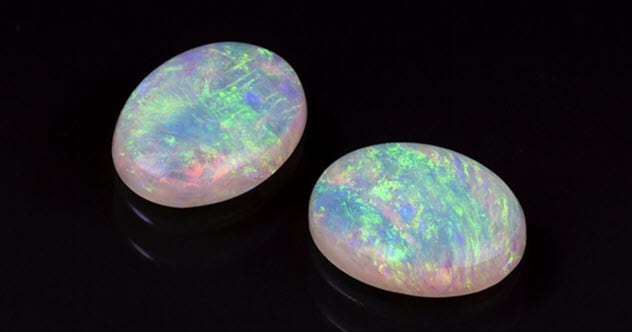
Opal is a delicate gem but one that has always fetched a high price. Pliny the Elder tells us of one rich man who had to flee with almost no property but still managed to escape with a fortune thanks to his opal. “Nonius took to flight, carrying with him, out of all his wealth, nothing but this ring, the value of which, it is well known, was estimated at two millions of sesterces.” Before the discovery of large amounts of opal in Australia opals were exceedingly rare in Europe.
The superstitions associated with opal are as varied as the many colours they shine with. Some thought that the opal was protective and would turn pale if there was poison nearby. Opals were thought to be tied to their own and would lose their brilliance when the owner died. Others thought that they were evil gems.
Opals were said to give people the gift of invisibility. Perhaps for this reason one Christian bishop said the opal is “the guardian of the thievish race; It gifts the bearer with acutest sight; But clouds all other eyes with thickest night.”
1 Diamond
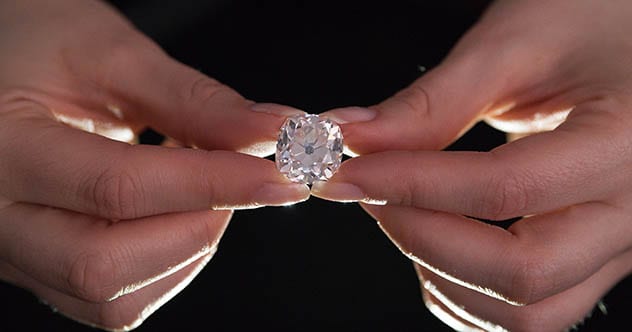
No gem is more highly desired than the diamond. Its crystal structure reflects and refracts light into gorgeous patterns. Diamonds were also the hardest material, giving them a divine status. In Hinduism the god Indra uses a weapon called Vajrayudham that is made of diamond. All diamonds were once mined in India, until deposits were discovered in Brazil in the 18th century.
Many legends sprung up around diamonds. In Europe many large diamonds were said to have been stolen from Indian statues of the gods. Some thought that the massive blue diamond now known as the Hope Diamond was plundered from the forehead of an Indian statue. It is perhaps because of this sacrilege that the Hope was said to be cursed. The first owner, and maybe thief, is supposed to have been torn apart by dogs after he stole it. Later owners suffered similarly gruesome fates – at least according to legend.
Given the value placed on diamonds there was almost no lengths that people would not go to in order to get their hands on them. In a late legend about Alexander the Great he came up with a novel method of stealing diamonds from the Valley of the Jewels. Because the diamonds were guarded by poisonous snakes Alexander threw bits of meat into the valley. The diamonds stuck to the meat and then birds swooped down to snatch the meat. When they carried the diamond encrusted meat out of the valley the birds were scared off and so the diamonds were gathered up.
Top 10 Reasons Diamonds Are Not As Great As You Think They Are








